
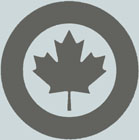 Credit:
Roundels of the world
Credit:
Roundels of the worldRoundel Low visibility roundel

 Credit:
Roundels of the world
Credit:
Roundels of the world
Roundel Low
visibility roundel
Last update 16-02-22
Procurement
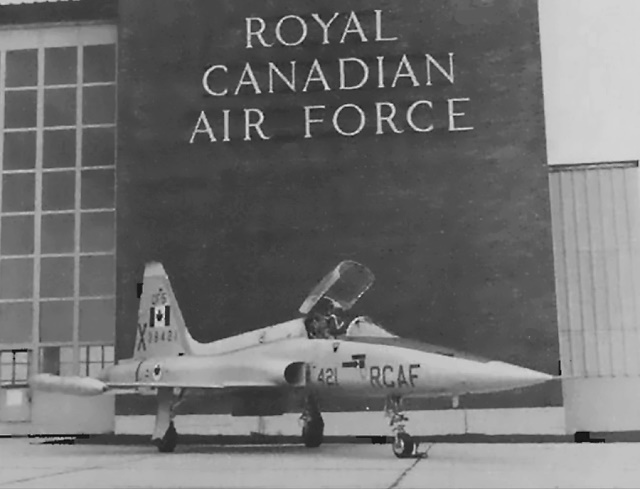 Photo: Northrop
Photo: Northrop
Demonstration Northrop
F-5A in front of a Royal Canadian AF building, mind X (experimental) on
tail
By
the mid
1960s Canada had 5 all-weather fighter Squadrons equipped with McDonnel
CF-101F
based in Canada and 8 attack Squadrons
equipped with
Lockheed/Canadair CF-104 in Germany.
A new
fighter had to be selected to
replace at least a part of these aircrafts which were quite expensive
to
operate. In 1964 a wide range of aircrafts were evaluated to replace
both the
CF-101 and the CF-104.
The Ministry of National Defence had a strong
preference
for the Mc Donnel F-4 both in the General Electric J-79 or the Rolls
Royce Spey
engines equipped versions, in view of its all-weather capability and
the
foreseen deployment to Central Europe to support NATO in case of an
aggression
from the Warsaw Pact countries.
The F-4 was rejected by the
government
due to costs consideration and the requirement was changed to a light attack
aircraft, reducing the
choice to the Douglas A-4E Skyhawk, Grumman A-6A Intruder,
LTV A-7A
Corsair and
the Northrop F-5A Freedom Fighter. A two-seat version of the selected
aircraft
was also to be bought.
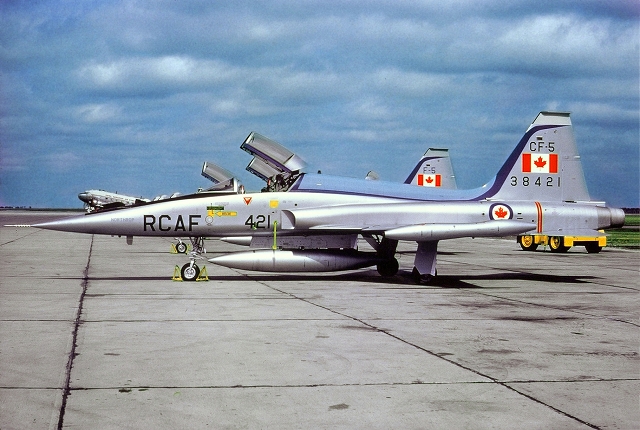
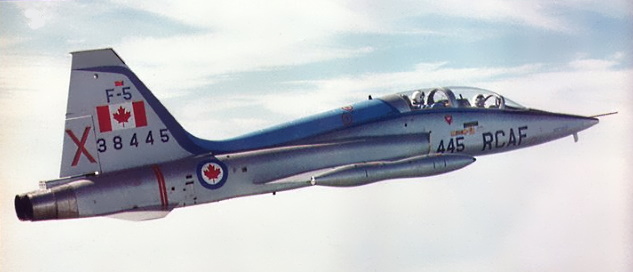 Photo:
Northrop
Photo:
Northrop
Two-seat
demonstrator 38445 in flight, September 1968
The Air
Force
showed preference for the LTV A-7A Corsair, but, as in so many cases,
its
wishes were not heard and the government announced
in July
1965 the selection of the Northrop F-5, a fighter affordable to
buy and operate, to be in-flight
refuelled by
Lockheed C-141 tankers and to be built under licence in Canada in order
to sustain the local aviation
industry.
After negociations, a manufacturing licence was granted by
Northrop to Canadair at Cartierville
(near
Montreal), while the engines were to be built by Orenda Ltd.
The Canadian NATO commitment
was
switched, in view of the lighter attack aircraft, from the heavily
armoured Centra European front to the
Northern
flank, which was less critical and where Norway operated a similar
aircraft.
to improve take-off run by
almost 20%, as
well as improved navigation and communication equipment and additional armour).
 was the company selected to produce the new fighter
was the company selected to produce the new fighter
The
Canadian model obtained three designations =
Northrop: CF-5A and CF-5D; Canadair: CL-219-1A10 and CL-219-1A-17 - Canadian
Forces: CF-5
and CF-5D respectively for the single- and the double-seaters.
CF-5A equipped for a short
time with
reconnaissance nose obtained the provisional designation CF-5A(R); Canadair built 50 reconnaissance noses that were tested at Elmensdorf (Alaska) in May1968.
Serials
were given starting with 14701.
A total
requirement for 218 CF-5s was foreseen
to equip 6 Squadrons of the Mobile Command plus attrition reserves, but the initial
orderplaced at the end of 1965 , at a
cost of CAD 215 millions, was only
for 89
single-seaters and 26 two-seaters,
delivery
to start from 1969. These enabled the establishment of 3 Canada based Squadrons, deployable
to Europe,
plus an Operation Training Unit at Cold Lake AB and a flight
in the test Squadron.
In 1968
budget reductions and costs escalation (to
CAD 296 millions) imposed to limit the number of deployable Squadrons to two,
imposing
the storage at either
CFB North Bay
or CFB Trenton of 15 new-built
CF-5As and 7 CF-5Ds. These were
to rotate with operational aircrafts in order to avoid costly build-up of modifications as earlier
experienced with long time stored aircrafts.
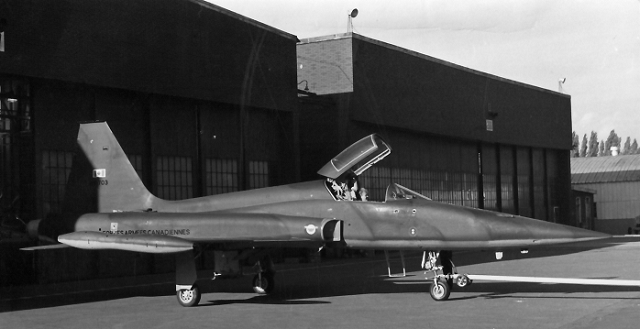
Roll-out
of the third
built single seater at Cartierville on 06-02-68. This was the first to
fly from
Cartierville.
Photo: Archive The Northrop F-5
Enthusiast
This was the
only confirmed
CF-5
serialled in this sequence, as on 01-02-68 Canada's Army, Navy and Air
Force
were united into a single force as
the Canadian
Armed Forces/Armeés Canadiennes and the single
seaters obtained
serials starting from 116701, the two-seaters from 116801.
First
flight of Canadian built F-5s (on 06-05-68, CF-5A now serialled 116701)
and flight testing of the first and second production examples (serial
116702 rolled out at Cartierville May 6, 1968) took place at the
main
USAF test base, Edwards AFB in California, having been flown over by
Canadian C-130Es; CF-5A 116701 was officially handed over to the Mobile
Command on 05-11-68, but lost on 03-12-69 at Edward
during tests; it
was replaced by CF-5 116702. The third example built and first two-seater, CF-5D 116801, flew for
the first time on 28-08-68 at Cartierville.
Production
at Canadair proceeded; 10 CF-5s
were in Air Force use on 31-12-68, by beginning of March 1969 15 CF-5As
had been completed, 47 CF-5s beginning of April 1970, production tempo
working up at
7 aircrafts per month, delivery to operational units
having started in January 1969, pilots initially
going to
Williams AFB in Arizona for training with 425 Squadron (USAF) while
their planes were being built.
The first
squadron to form was No. 434 "Bluenose" in 1968, the first CF-116D
(116802) was flown to 434 Squadron at Cold Lake on November 5, 1968.
The second squadron (No. 433 "Porcupine") formed at
Cold Lake shortly
thereafter. It was formed on August 25, 1969.
As the
1968 defence budget restrictions imposed a reduction to only two
deployable operational Squadrons and a training unit it was realised that the
number of aircrafts available was over the actual need of
single-seaters
The request to purchase 16 CF-5A and 4 CF-5D by the
Venezuelan goverment came most welcome. In 1972 16 unused
single-seaters (inclusive the last Canadair built) and 4 two-seaters (2
having been built
especially for this country) were transferred
to the Venezuelan AF, starting a dispute with Northrop regarding
royalties to be paid, settled only in 1976 with the payment of USD 9
millions.
As a compensation for the loss of the aircrafts transferred to
Venezuela, 18 new CF-5D were ordered for the Canadian Air Command, the
last first flown on 22-11-74 and delivered to CFB Cold Lake on 31-01-75.
Canadian Forces took delivery of altogether 115
CF-5A/Ds between November 5, 1968
and September 21, 1971, 54 being on
this last date operational with 433 and 434 Squadrons, each having
between 2 and
4 CF-5D two-seaters for pilot proficiency check; 44 CF-5s were in storage at CFB North Bay
and Trenton
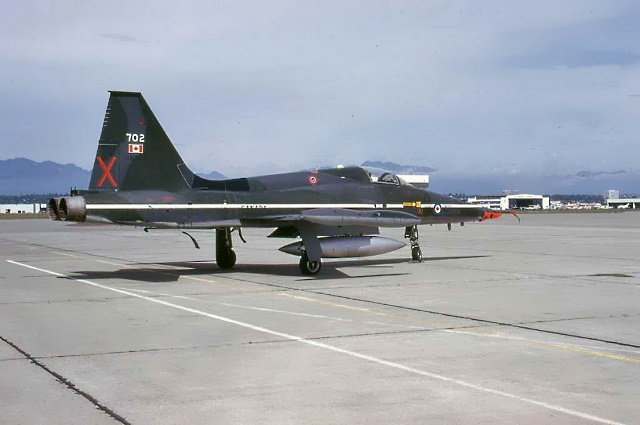 Photo: Archive Dr John Blatherwick
Photo: Archive Dr John Blatherwick
CF-5A 116717 AETE at Vancouver in September 1975. Note trials, red reconnaissance nose
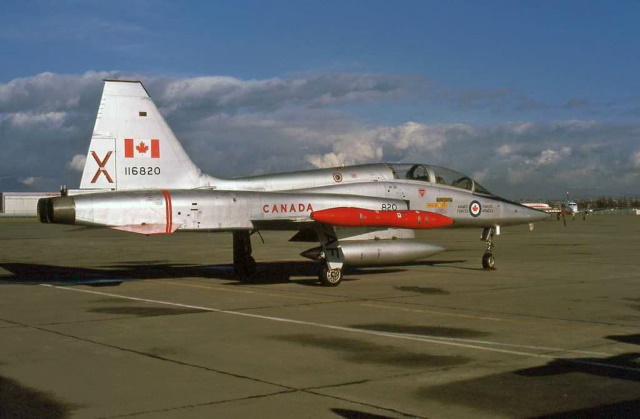 Photo: Archive Dr John Blatherwick
Photo: Archive Dr John Blatherwick
Canadair CF-5 116820, AETE, at Vancouver in February 1976; metal colours, X on tail
By mid
1972, 50
air-to-air refuelling probes built by Canadair were delivered to enable
non-stop transfer of CF-5As to be deployed to Norway, in-flight
refuelled by 2 second-hand B.707/CC-137 as the originally
foreseen
Lockheed C-141 in tanker configuration was not built.
The
year
1975 saw
another round of Defence budget savings resulting in the decision to
reduce the strength of the two operational Squadrons from 27 to 20
aircrafts, the surplus aircrafts joining those already
in storage.
Twelve additional CF-5A equipped No. 1
Flying Training School, while 6 had been lost in accidents.
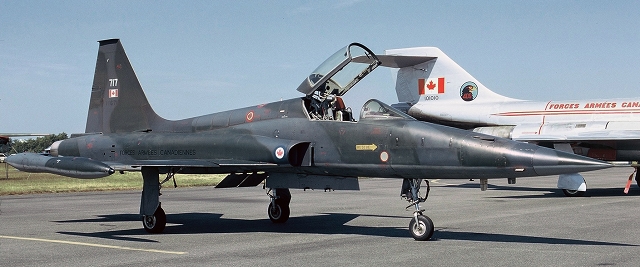 Photo: Gerald Helmer
Photo: Gerald Helmer
Canadair CF-5A 116717
433 Squadron, but without badge, French inscription in 1975
Photo:
Larsen
Remington/Archive The Northrop F-5 Enthusiast
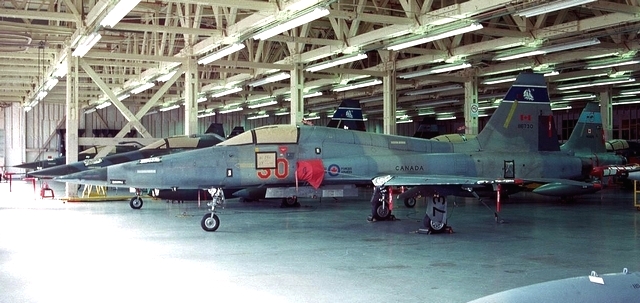
Canadair CF-5A 116730
formerly 433 Squadron on store at
Trenton
Photo:
Larsen
Remington/Archive The Northrop F-5 Enthusiast
By mid 1977 the statistic showed 73 CF-5A/CF-5D in use, 31 in storage, 11 lost in accidents; during the early '80 there were 28 aircrafts stored in a hangar at CFB Trenton, see photo above.
The second prototype of the Borthrop YF-17 was demonstrated in Canada in 1978 in a bid to replace all fighters at the time (Canadair CF-5, Canadair CF-104 am McDonnell CF-101) but was not adopted.
Bad news
was the
appearance of mainspar fatigue cracks in 1986, seriously affecting the
fleet; after initial grounding for inspection and modification
apparently only 29 operational aircrafts were left, 10 of these
being
in use by 434, 17 by 419 Squadron, 2 by the AETE.
Upgrade
Following
these unexpected airframe problems engineering studies for the
modification of existing CF-5As and CF-5Ds were launched, completed at
the beginning of 1987. The aim was to provide an aircraft
capable of
bridging the performance gap between the Canadair CL-41 Tutor and the
CF-18. The studies recommended complete rewiring of the aircraft plus
various airframe parts/wings replacement/
strengthening; installation of
a HUD display, a weapons aiming and computing system, a digital air
data computer, an inertial navigation system was also suggested because
some of the existing exuipment was
no longer supportable and to make
the aircraft more suitable to transitioning a pilot into the new
McConnel Douglas CF-18.
Initial
contract, for the estimated cost of CAD 100 millions, was awarded in
November 1988 to Bristol Aerospace to remanufacture 23 CF-5A and 33
CF-5D airframes, to be executed at the company's Winnipeg,
scheduled
delivery to be one aircraft per month until completion in 1994. The
remaining 36 non-upgraded aircrafts were to be retired from service.
In a separate programme, tests started in Februar 1989 and to be completed by 29-03-91, an unmodified CF-5 (116729) was to be tested to
complete 24'000 simulated flight hours, test aimed at proving
a
2'000 hour increase in the CF-5's service life, leading to the
(modified) aircraft being cleared to 8'000 hours.
First reworked prototype CF-5D, serial 116841, was rolled out at
Winnipeg in August 1989, first flight only on 14-06-91.
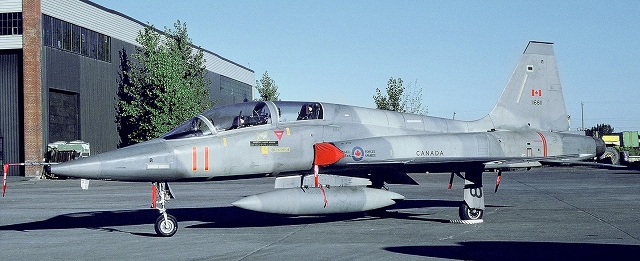
Canadair CF-5D 116811 in aggressor colours, without Squadron badge,
Montreal St Hubert 08-09-90
Photo: Alain Rioux/Archive
The Northrop F-5 Enthusiast
In the
meantime 434 Squadron had been
disbanded on June 01,1988 due to defence spending cuts resulting from
the reduced 1988 federal budget and 434 Squadron had started conversion
to the
McDonnel CF-18 at
the beginning of 1988; CF-5s were now only needed for
the training task and the number of
aircrafts to be converted was reduced to 46.
A contract to upgrade the avionics
suite of 46 CF-5s, worth CAD 70 millions, was granted to Bristol
Aerospace during November 1990. This programme also covered the setting
up of a new software database, training
simulator and test and
evalaution equipment. The entire two-phase (airframe/avionics) was
planned for completion by 1995.
Testbed for the avionics modification was the cockpit of CF-5D 116804,
aircraft damaged on 03-03-69; two prototype single-/two-seaters were to
be used for trials. Avionics updated prototype CF-5D flew for the first
time on 14-06-91, at Cold Lake.
Retirement
The 1994
annunced Defence Policy White Paper budget cuts meant the
retirement of Canadair CF-5s fleet, though the estimated life
expectancy was to the year 2000. Student pilots had to proceed directly
from the
Canadair CL-41 Tutor to the, quite higher performing, McDonnel
Douglas CF-18.
Upgrading was reduced from 46 to the 36 aircrafts, those that Bristol
Aerospace had completed at the time. Contempourarely, in April 1994, an agreement was reached, following a July 1993 lawsuit by Northrop (the
original aircraft developer) against Canada/Bristol
(aircraft licensee/engine builder). New licenses were given enabling to
continue to use the aircraft technology for own maintenance. Bristol
received the opportunity to
compete for business on worldwide available
Northrop F-5A and F-5B and teamed with Northrop for the Northrop
F-5E/F-5F as principal subcontractor to Northrop International.
No. 419
Squadron's 25 updated CF-5s left Cold Lake between mid and end
of March 31st, 1995 to fly for storage at CFB Trenton;
AETE at Cold Lakehad already transferred there Trenton the prototypes
of the single-
and double-seaters but continued testing the upgraded
CF-5s unil the end of 1995, these proceding then to CFB Trenton for
storage and resale.
This marked the
final phase of CF-5's use by the Canadian Forces, spanning some
twenty-seven years and closed a significant chapter in Air Force
fighter history.
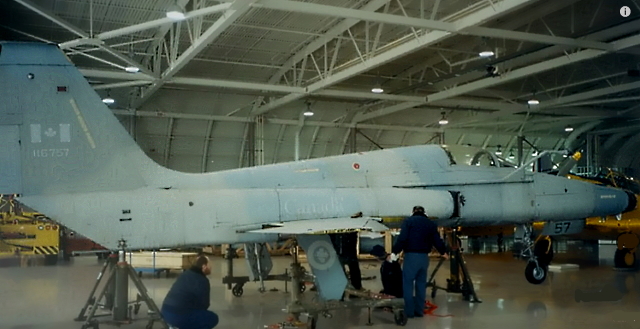
Preparing Canadair CF-5A 116757 for storage.
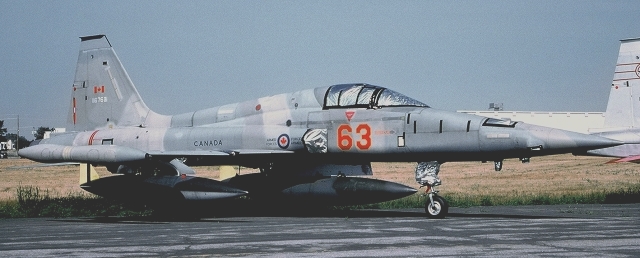
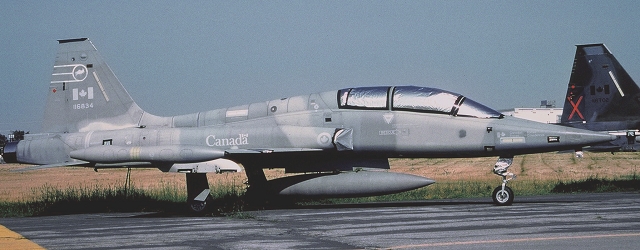
Aggressor
Canadair CF-5A ex 419
Squadron stored at Trenton in 1995
Canadair CF-5D 116834 ex 419
Squadron stored at Trenton in
1995
Photos: Archive the
Northrop F-5 Enthusiast
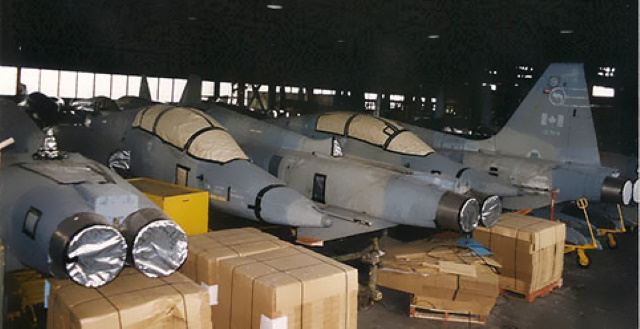
Unsold, dismantled 419/433 Squadron Canadair CF-5D stored at Trenton
Last
upgraded CF-5 was flown directly from Bristol Aerospace plant at
Winnipeg to storage at CFB Trenton by 419 Squadron and
AETE pilots on December 1995, never having been used by the Air Force.
All
stored aircrafts were up for sale or preservation; by Decenber 2000 there
were following aircrafts for sale, divided in three categories:
1. 2 single- and 18 dual aircrafts: avionics,
structural and wiring systems upgraded -
2. 7 dual aircrafts: structural
and wiring
systems only upgraded
3. 10 single- and 5 dual aircrafts: in original configuration.
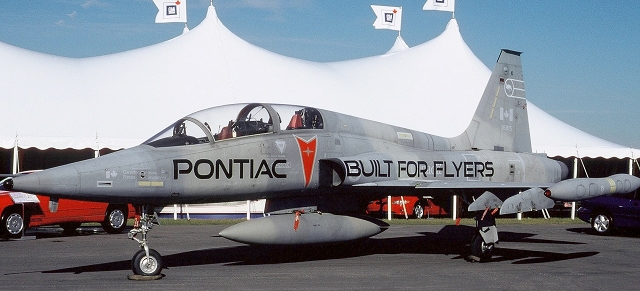
"Special
purpose" Canadair CF-5D 116815 ex 419 Squadron on show at Trenton
23-06-96
Photo:
Terry Panopolis/Archive The Northrop F-5 Enthusiast
Two CF-5Ds, serials 116833 and 116839, were kept in a flying status
with
Bristol Aerospace for test and demonstration purposes to possible
buyers.
Bristol Aerospace could already announce on 04-06-96 the sale of 10
upgraded CF-5A and 3 upgraded CF-5D to Botswana, first three to be
delivered in September 1996.
There
were even negotiations in 1998 with the US Navy for the lease of
between 14 and 16 CF-5A/D to augment the US Navy adversary aircrafts.
The fighters were to be provided free, with Bristol Aerospace being
paid
to maintain them during the lease period, which could have run for
between three and seven years.
Discussions were also
held with several
other countries, including Greece in 2001 (28 F-5s, cost USD 75m), the Philippines, South Korea and
Thailand, for
the remaining 47 aircrafts. The Philippine, if realized, was to be
rather a special sale, as it was foreseen to barter the aircrafts
against raw material.
Sales did not materialize; only 3 additional
single-seaters Canadair CF-5A and 2 two-seaters Canadair CF-5D were
sold and delivered to Botswana in
the year 2000.
By
February 2004 following aircrafts were on a sales list: 2 Canadair
CF-5A, 18 Canadair CF-5D upgraded DAR (DLIR + Avionics + Rewire)
DLIR = Depot Level Inspection and Repair maintenance
7 Canadair
CF-5D upgraded DLIR only
9 Canadair CF-5A in original
configuration
Hope for additional sales was given up by the end of 2006, when the
aircrafts were withdrawn from sale, having generated revenues
exceeding CAD 120,000,000. In the meantime
the airframes had been mainly
transferred from CFB Trenton to CFB
Mountain View, some also having been handed over to museums and others
kept for preservation or instructional purpose at various Canadian
bases. See CF-A and
CF-5D serials
lists for
details.
At least eight CF-5A were stored at Markham airport in 2007.
Civilian company Tactical
Air defense Services announced in September 2010 that it had
acquired 6 Canadian CF-5s plus 45 General Electric J-85-15 engines
for USD 6m from Crown Asset Distribution;
six additional
CF-5D were registered to Global Aviation International
from Jupiter (FL) on 15/16/17 July 2013. Hangars storing them at Mountain View AB were dismantled between 2012 and
2014; the flyable aircrafts were flown
out and the others
transported by truck. In July 2017 there were only 2 Canadair CF-5D and 16 CF-5A left at Markham airport.